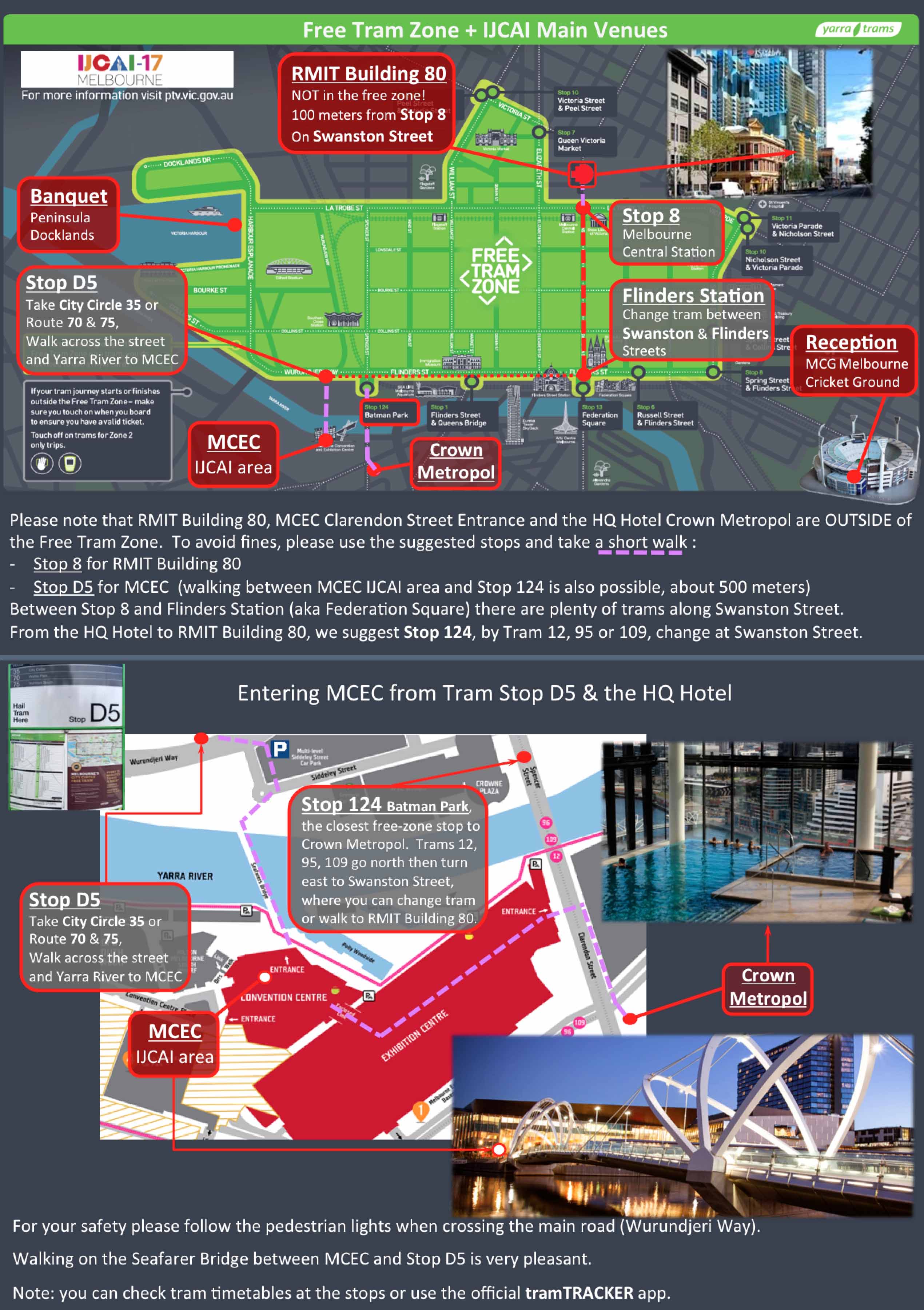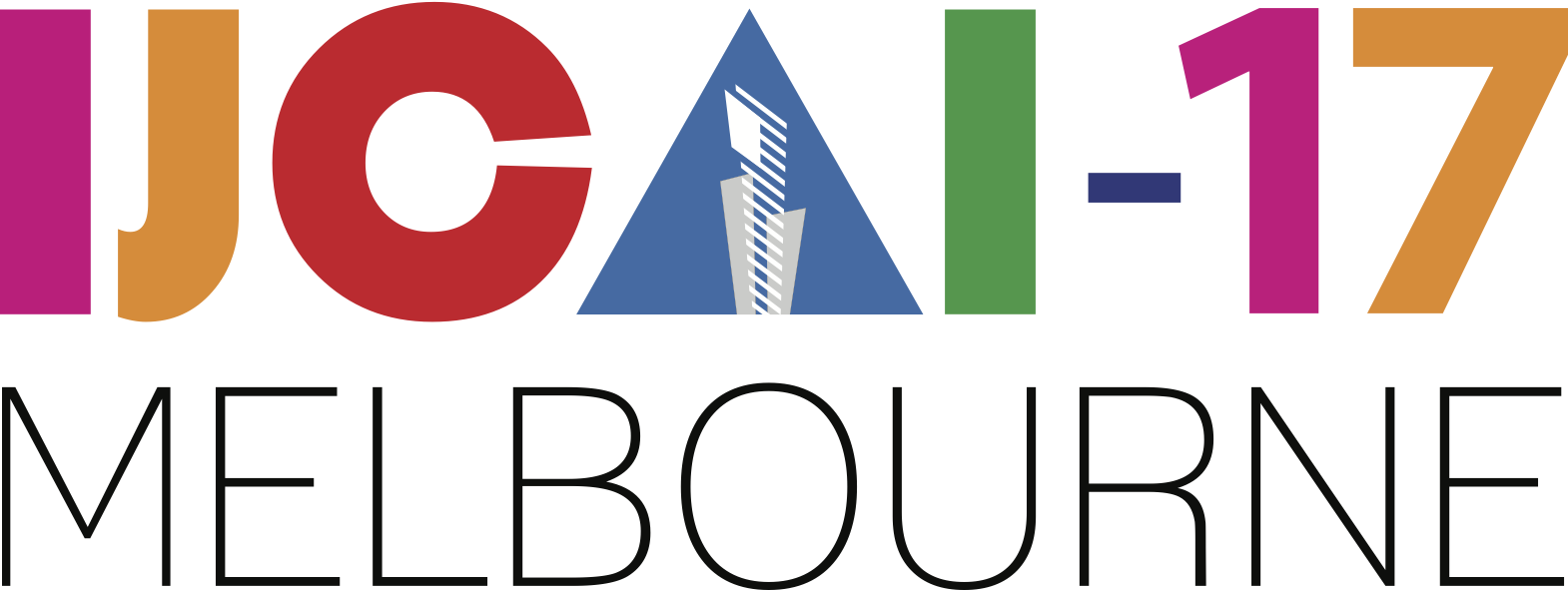Local Info
The local map below shows the major venues of IJCAI 17, suggested travel pathes as well as the free tram zone of Melbourne. Travelling inside of this zone is totally free and does not require a Myki Card. However any tram ride outside of the zone needs a valid Myki Card with sufficient amount of fund on the card (details see here ). Melbourne does have a large number of ticket inspectors roaming around tram, train and bus stations.

- Currency
-
Australia's national currency is Australian Dollars (AUD), which comes in denominations of $5, $10, $20, $50 and $100 notes. Coins come in 5, 10, 20 and 50 cent and one and two dollar denominations.
Credit cards such as American Express, Bankcard, Diners Club, MasterCard, Visa, UnionPay and JCB are accepted in Australia. VISA or MasterCard can be used everywhere credit cards are accepted. American Express and Diners Club are accepted at major supermarket and department store chains and many tourist destinations. A good tip is to carry multiple credit cards and a little cash. Merchants may impose credit card surcharges in some places.
Traveller's cheques are not widely accepted in Australia. If you do purchase traveller's cheques, it is best to buy them in Australian dollars as smaller shops, restaurants and other businesses are unlikely to know what the exchange rate is if you present a cheque in a different currency such as US dollars or British pounds.
Australia has a Goods and Services Tax (GST) of 10 per cent. You may be able to claim a refund for the GST paid on goods if you have spent AUD $300 or more with a single business, no more than 60 days before departing Australia. Tourist Refund Scheme facilities are located in the departure are of international terminals. - Banking & buying Australian Currency
-
Currency exchange is available at banks, hotels and international airports. Australian banks offer the same range of services typical in other western nations, and Automated Teller Machines (ATMs) are widespread, although facilities may be limited in remote towns and the Outback. EFTPOS is also widely available in most Australian shops allowing you to pay for purchases with your credit or debit card. Fees may be charged on transactions, particularly if withdrawing from an international account.
Australia's four largest banks are: NAB (National Australia Bank), ANZ (Australia New Zealand Bank), Commonwealth Bank of Australia and Westpac Banking Corporation. There are many smaller banks too, including ING Direct, AMP Banking and HSBC Australia. Banking hours are usually 9.30am-4pm Monday to Thursday and until 5pm on Friday. Some branches open on Saturday mornings until 1pm.
XE Currency Converter will help you convert your own currency at the current exchange rates.
- Weather
Australia's seasons are at opposite times to those in the northern hemisphere. June to August is winter, and during August Melbourne experiences average maximum temperatures of around 14 degrees Celsius (or 57 degrees Fahrenheit) and average minimum temperatures of 6.7 degrees Celsius (or 44 degrees Fahrenheit). Melbourne typically experiences around 50 mm average rainfall in August.
- Time Zones
-
Australia is divided into three separate time zones: Australian Eastern Standard Time (AEST), Australian Central Standard Time (ACST), and Australian Western Standard Time (AWST).
- AEST is equal to Coordinated Universal Time plus 10 hours (UTC +10).
This covers the following states (which includes Melbourne); Queensland, New South Wales, Victoria, Tasmania and the Australian Capital Territory.
- ACST is equal to Coordinated Universal Time plus 9½ hours (UTC +9½).
This covers the following states; South Australia and the Northern Territory.
- AWST is equal to Coordinated Universal Time plus 8 hours (UTC +8).
This covers the state of Western Australia.
- Tipping
-
Hotels and restaurants do not add service charges to your bill, and tipping is always your choice. In upmarket restaurants, it is common to leave a tip to waiters of 10 per cent of the bill for good service.
Some restaurants and cafes will add a 10 per cent surcharge to prices on weekends and bank holidays. This is supposed to cover a slightly higher minimum wage for working these days. Some will also charge an extra 1.5 to 3% for card payments. These extra charges will be clearly stated on the menu or at the cash register.
- Electrical plugs
You may need an adapter in order to plug your appliances into the power sockets: the adapter required for Australia is Type 1 Australia plug. The plugs in Australia have two flat metal pins, forming an inverted 'V' shape, and occaisionally a third pin in the centre. The electrical current in Australia is 220-240 volts, AC 50Hz
- International dialling codes
-
The international dialling code for Australia is 61. Each region also has an area code, including Central East (New South Wales, Australia Capital Territory) with area code 02; South East (Victoria, Tasmania) with area code 03; Mobile telephones (Australia-wide) with area code 04; North East (Queensland) with area code 07; and Central and West (Western Australia, South Australia and Northern Territory) with area code 08. When calling from outside Australia, leave out the leading '0' from the area code or mobile phone number.
- The outgoing IDD (international direct dialing) code from within Australia is 0011.
- Mobile phone network coverage is available across Australia, however coverage may be limited in some remote areas.
- Internet access and free WiFi is widely available at internet cafes, accommodation and libraries.
- The emergency number in Australia is 000
- Sending Mail
-
Post offices are usually open 9am-5pm, Monday to Friday, with some city post offices open on Saturday morning. Travellers can arrange to collect mail at post offices throughout Australia.
- Left-Hand Traffic
In Australia cars, trams, bikes and other vehicles travel on the left-hand side of the road of a bi-directional traffic. Pedestrians also walk on the left-hand side of a path or a corridor in general. Look to your RIGHT first then left to check incoming traffic when crossing a street or road. Same rules apply when you are making turns when driving. The steering wheel of an Australian car is on the right-hand side.
The following local info will be made available soon:
- Food guide
- Foodmap RMIT
- Foodmap MCEC

